-
Posts
507 -
Joined
-
Last visited
Content Type
Profiles
Forums
Store
Help Articles
Posts posted by gsquared
-
-
I'd go with it, if thats what you feel like!
Lets see the baguettes before you bake though, they may need an extra hour...they should look like they have inflated a bit
Great! I do not want to go too deeply into the evening - the innkeeper needs his rest. More follows.
-
I'd suggest:
a) A little less water - maybe 300g to make the dough easier to handle. Different flours adsorb different amounts.
b) A little less proving time. You might try refrigerating overnight pretty well as soon as you have shaped the dough. I used to do that with some success. Now I tend to prove for 3-4 hours and bake straight, although I have in the oven now some baguettes that I proved for 2 hours and then refrigerated overnight and they have sprung fine. You might want to prove for 3 hours hen bake, then add the refrigeration step when the basic dough is OK.
The Artist chided me for not following my teacher's suggestions. She was, of course, correct. As usual (damn irritating habit some women have). So, Jack, I will make the dough, prove for 3 hours and then bake. The preferment has been sitting for 10 hours now. This is what it looks like:
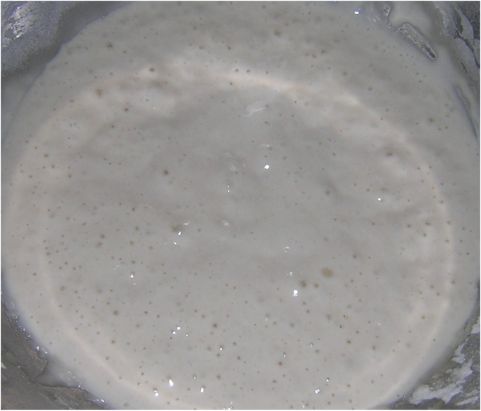
Do you think I can start the dough or should I wait 2 more hours?
-
third times the charm. 2 down, 1 to go!
If you havent introduced your loaf to the birds yet, how about slicing it thinly, toasting and making bruschetta?
The garbage bag proving enclosure was close at hand......
-
Well, I suppose it was a bit much to expect a lifetime of failed baking to turn around in one go, but I'm disappointed with you, Gerhard. I felt heartened when I read Jack's "alas and alack." Commiseration is the beginning of comfort and renewed hope, I think. Idea for the failed loaves: Have sandwiches for dinner and tell the Artist it is a new invention -- panini that doesn't need to be pressed. She might go for it...
Onward and upward!
Commiseration appreciated, Lori. The Artists is far too savvy to fall for that - she has been following all this attentively (and supportively!)
edited to fix accidental click
-
I suppose the teacher should teach by demonstrating, but this is cruel, Jack!

-
Thanks for the good wishes, Anna, TP and Russell. I am motivated by the fact that it is not my reputation as a bread baker at stake here. That is pretty much non-existant. I cannot allow Jack to fail as a teacher.

-
Oh dear! Alas alack!
I'm very puzzled, it all looked like it was going so well. The dough often deflates some when you slash it, but it recovers in the oven.
Maybe it was that pause with the preferment overnight, but I often do that, and the fact that the dough deflated showed there had been some activity.
However it does look like the the bread has been somewhat overproved - wet and little oven spring.
Another thought. Did you use bottled water for the dough? I know you did for the preferment, and if your local water has a lot of chlorine in it that can affect the yeast.
I'd suggest:
a) A little less water - maybe 300g to make the dough easier to handle. Different flours adsorb different amounts.
b) A little less proving time. You might try refrigerating overnight pretty well as soon as you have shaped the dough. I used to do that with some success. Now I tend to prove for 3-4 hours and bake straight, although I have in the oven now some baguettes that I proved for 2 hours and then refrigerated overnight and they have sprung fine. You might want to prove for 3 hours hen bake, then add the refrigeration step when the basic dough is OK.
I do hope you will persevere....
Thanks, Jack. Of course I will persevere.
Yes, I used bottled water for both the preferment and the dough.
I am suspicious of the amount of water/flour. The preferment I mixed this morning with 100g flour and 100g water seems stiffer than the one in the EGCI thread.

So, I think that I will change only one variable, and that is the quantity of water as you suggest. I will make the dough early eveing, allow 2 hours proving, overnight in the fridge and then bake off. D'accord?
O yes, I fixed the oven light and will use the oven for proving and for keeping the preferment at 30C.
-
No Lagavulin for me this morning, I fear.
No oven spring at all, in fact no spring of any nature.

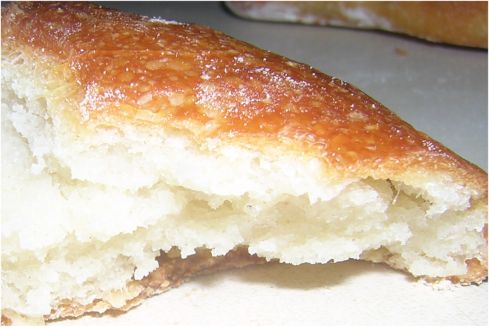
Oy Vey!
I shall start a new preferment and wait for Jack.
-
I think that I am a cautious man. The Artist maintains that I am a pessimist. Be that as it may, I baked off two trays of muffins first this morning. At least the guests will have something should all go awry with the bread.
I turned the shaped loaves onto two small, floured pans to use as peels, and slashed. Maybe I was not firm enough with the slashing........
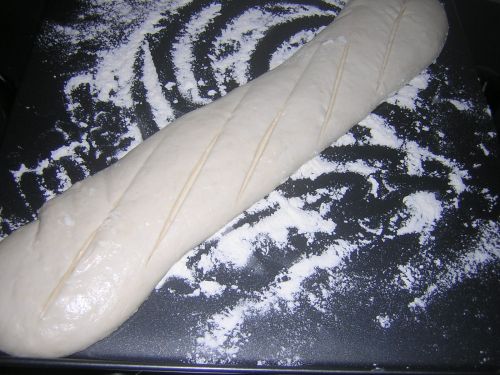

The loaves immediately flattened out, sort of subsided into flatter shapes when I removed them from the couche.
Oven preheated to 240C with cast iron pan for steam. The peels did not work well. I had to nudge and prod to get them onto the baking plate. I will definitely get myself a strip of wood to use as a peel. In any event, they are in the oven. And I wait. Too early for a small libation, but should this come out even halfway decent, by gad, I shall have a glass of Lagavulin. Peering outside, I see the seagulls gathering......
-
Whooo hooo hooo--There's gonna be different kind of TOUCHDOWN* today!!!
Go Gerhard Go Gerhard
*picture both arms raised straight up in triumph

Thanks K! I am trying to curtail my optimism, but confess that I am looking forward to tomorrow. What if Jack has actually pulled me through? The Artist is apprehensive. She fears that if, no, when this works out, I'll go into a frenzy of baking. She's right, of course. I have a lot of leeway to make up.
-
Entirely up to you.
The results are slightly different, and I prefer the retarded (fridge) version. The crust in retarded loaves has characteristic fine bubbles, and is slightly redder, due to the extra sugars.
Great - that's what I'll do. Into the fridge until the morning. The dough can go cold into the ove, right? No need to get it to room temp first?
I have to confess to a moment of alarm when there was no sign of a rise.......
-
Almost forgot - here is a peek into the bag at 2 hours.
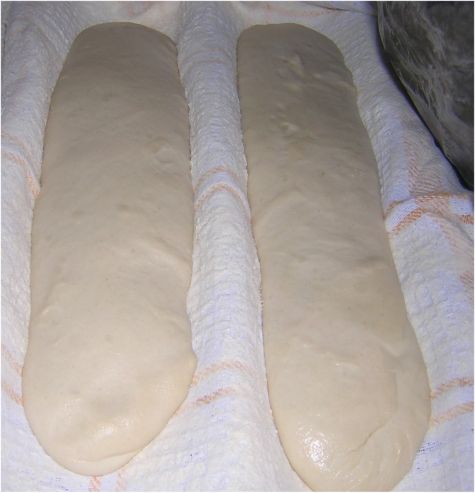
-
Sorry to be late checking in. Both me and the computer had trouble waking up.
The bread looks great! The leaven will wake up when it gets more food, its hungry
After 2 hours the dough will begin to move a bit, but probably not double. Its quite a subtle change.
The major volume increase will come from spring in the oven, and its better for the dough to be under proved than over proved.
Are you going to put it in the fridge, or let it prove for 4 hours and bake it today?
Theoretically, which option would be prefereable? I was leaning toward leaving it in the fridge until tomorrow.
-
As per Jack's instructions, I put the ingredients into a food processor and whizzed for 2 minutes. Looked good.
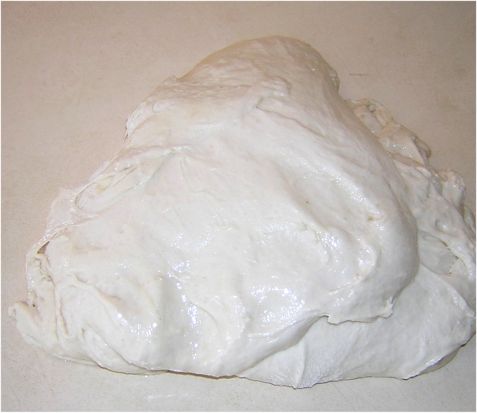
This is what it looked like after removing it from the Magimix. The glint is due to the oil on my hands.
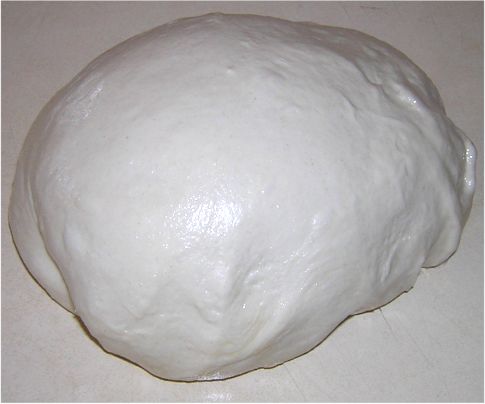
Folded as per instructions.
I had a baguette pan around and used that as the couche - made getting it into the bag easier. I am not so sure that the shapes are good, but the wet dough is not all that easy to shape.
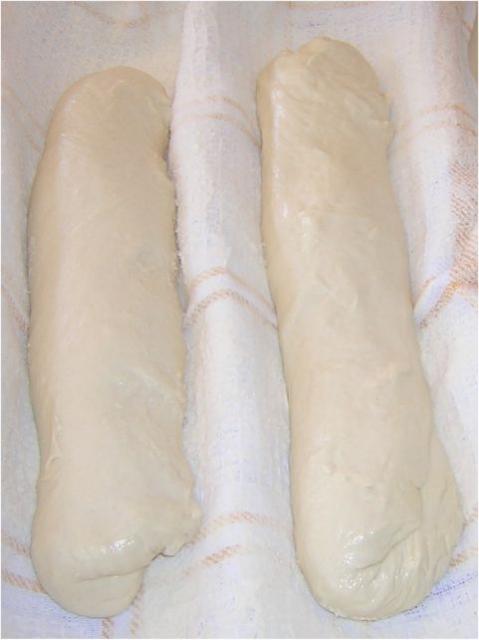
Into the bin liner. Actually a garbage bag - I do hope that is not an omen. Note the printout of Jack's instructions lying on the scale.

Two questions, Jack:
I left the preferment overnight and removed it from the 30C environment early this morning. When I got around to mixing the dough, the preferment had only a few small bubbles - it seemed pretty dormant. I assume that the additional food and 2 hours at 30C will revive it?
Should I see a doubling in size during the 2 hours proving? Will insufficient increase in size be a harbinger of doom? I think I will post a pic after two hours before putting it in the fridge.
-
I'm excited for you too...bread virginity...
The dough will need a total proof time from mixing to bake of about 4 hours. Overnight in the fridge is roughly equivalent to 2 hours warm, pretty well regardless of how long you leave in in the fridge (above say 4 hours in the fridge, and up to a few days) since it goes on proving a bit while it cools down. Thus you can mix, prove for 4 hours, then bake directly; or mix, prove the dough for 2 hours, refrigerate until ready, then bake from cold. I suggested this latter since it might suit your breakfast schedule better, and the cold dough is easier to handle.
Great! I shall wait until the morning then.
Not so sure about the bread virgin. Maybe closer to erectile dysfunction?
-
I'd give it a few hours more, if you can (I don't know what time it is there). Up to 24 hours is OK.
Bear in mind that you will need 2 hours after mixing the dough, so you might want to leave it until the morning. Alternatively leve it a few hours then put it in the fridge (covered) until you are ready for the next step. Then take it out an let it warm up for a few hours in the morning. The great advantage of refrigeration is that you can do it when it suits you, rather than the other way round.
Thanks. It is now 15:30 here. I'll leave it until the morning, I think.
At what point does the food source provided by the 100g flour get exhausted?
Also, if I prefer to bake late tomorrow afternoon, will an 8 hour retarding in the fridge be sufficient? Should I rather make the dough in the morning, allow the rise and then leave in the fridge, probably for about 24 hours to account for my breakfast activities the day after?
Here are Jack's instructions:
For the next step you will need a something like a floured linen teatowel, achopping board and a rolling pin or equivalent.
Dough:
All the preferment above
500g flour (AP as above)
320g water
10g salt
1g Vitamin C (if you have any)
Put all the above in a strong food processor and whiz for 2 minutes.
The dough will pick up on the blade and then release.
This dough is very sticky indeed, and initially more like a cram than a
dough - don't panic, but make sure everything it touches is floured or
oiled.
In fact oil is probably easier than flour, at least initially. Wipe some oil
on a work surface and on your hands. Turn out the dough onto it. Otherwise
use lots of flour to tame the dough until you get used to it.
Fold sides to middle, and top to bottom twice - should begin to feel more
like dough. Divide into half and form each into a ball. Traditional way is
to take a corner and fold to the middle, rotate by 45 degrees and repeat 8
times around.
Form each into a baguette or batard shape: flatten the ball, then fold in
the corners then fold in half, and roll a bit.
Make the couche: Take your floured tea towel and wrap one end round the
rolling pin. Lots of flour or the dough will stick. Put one cylinder of
dough next to it, and fold up the tea towel. Then put the next piece of
dough and fold up the tea towel again, then another rolling pin or pieces of
wood.. Sort of like a W shape with the dough resting in the bottoms of the
V, supported either side, and with the centre fold separating the dough -
don't forget they will double or more. Put the whole thing in a large
plastic bag, like a bin liner and leave at 30C for 2 hours, then put in the
fridge.
Next day preheat the oven to hot (250C) with the empty heavy baking tin in
it. Also preheat an empty cast iron pan.
Might be useful to have a "flipping board": something like a strip of smooth
plywood or old floorboard the length of your baguette/oven/baking tray.
Flour it well, or use rice flour or corn meal. Roll a baguette carefully
onto it. Slash the top with five slashes (use a thin sharp knife or razor
blade), nearly parallel to the length, Roll off onto the hot baking tray in
the oven. Do the same of the other loaf. Throw a cup of water into the cat
iron pan (caution hot steam) and slam the door. Wait 40 mins, or until the
bread is well coloured.
Eats better if allowed to cool somewhat before cutting.
The thought of actually having something to cool before eating leaves me somewhat breathless. Like when you went on your first date.
-
The preferment has been going for 8 hours now. I am cautiously optimistic.
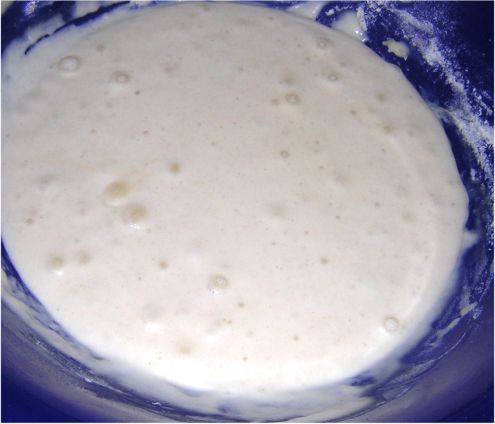
Ready to rumble or should I give it a few hours more?
-
Mother looks fine. I'd start the preferment. After all itd only 100g of flour if it doesn't work, but I expect it will...may need to leave the preferment for 24 hours, but see how it looks.
Ok. I'll let you know what the preferment looks like later this afternoon.
-
I do not know much about patents and even less about US law, but could it not be possible to register a recipe as a business method patent? It appears that this has mostly been used for protecting e-commerce ideas, but it does not seem to be limited in principle to software.
In order for a company or individual to get a business method patent, the business method or software must meet the following requirements:1. The method or software must be of a subject matter that the patent office defines as patentable. This is said to be anything created by humans that falls into two classes; laws of nature, natural phenomena and abstract ideas.
2. The method or software developed must be of some practical use.
3. The method or software must be novel.
4. The method or software must be what they call "non obvious." What this means is that somebody who has ordinary skill in that specific technology would not have been able to think of it.
-
Article about them. The recipes look interesting...will try them soon. Are they authentic enough?
Pretty authentic, except for the octopus potjie. Perhaps a nod to local preferences but all self-respecting S.A. potjiemakers will shudder at the thought.
-
The preferment is dead and discarded. The mother look more promising.

Jack:- leave it for longer or start the preferment again?
-
By the way, your intriguing blog encouraged me to have dinner at Our One-and-Only South African restaurant and we were not disappointed. A return for the more exotic stuff in the menu is highly likely.
Rooting for you. You're in good hands.
Thanks, TP!
I am somewhat amazed that there is an S.A. restaurant in Kuala Lumpur. "Kudu bar" though? Taking the concept of "watering hole" to the extreme?
-
Do you have a light in the oven?
Turn the light on, place the strter in the oven... that should give you a constant temperature... around 28C
Sometimes I proof my bread that way.
Thanks. The light in my oven is a teeny one, but I'll switch it on and take the temp.
-
Hmm...maybe the starter is not yet fully active.
No worries, just give the preferment a few more hours, if you can.
and refresh the starter (throw out half, add another 100gm flour and 100gm water0, leave out (ideally 30C but room temperature will do) for 24 hours.
Ok. Room temp is a chilly 18C today, so I'll try to keep both at around 28C. I'll report back tomorrow morning.



The rehabilitation of a failed baker
in Pastry & Baking
Posted
Shaped dough in couche. I'll post a 3-hour pic from the same angle later.